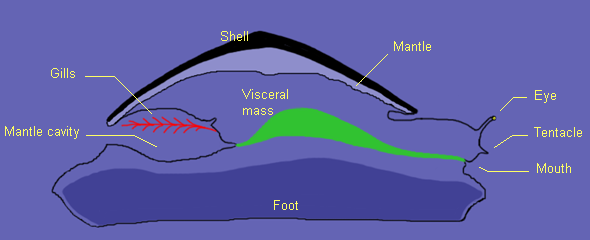
All molluscs have about the same anatomy, even if the animal shapes can be very different between classes.
The picture below illustrates the general anatomy of molluscs.

3 types of living style can be separated :
- Buried into the substrate:
This is the situation of most bivalves (Veneridae, Cardiidae etc.), they use 2 siphons (pipelike organs) that dig across the soft sediments
(sand, clay, etc.) in order to reach the surface. One of the siphons is used to bring new water (oxygenated and nutrient full) to the animal while
the other expulses the used water back into the environment.
Some gastropods live in the sediment aswell, they do not filter water for nutrient but they hunt for preys to feed on. Their diet consist
sometime in bivalves whose shells can be drilled to reach the animal.
- Fixed on solid materials:
Some bivalve can be cemented on hard substrate (Ostreidae, Spondylidae) or be tied to it with a byssus (Mytilidae). In these acases, the bivalve
just need to open its valve to breathe and to catch food from the environment.
A few gastropods live together in or with other party. They can dwell inside coral colonies or are very dependant to their elected substrate
(like Patellidae on their rock).
- Free on the ground:
This is the living mode of most gastropods, they crawl on the seaground searching for food and when they rest they usually choose an hidden
and sheltered place. The Pectinidae bivalves live aswell free on the ground, they can swim away from danger by clapping quickly
their valves.